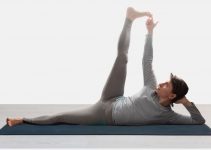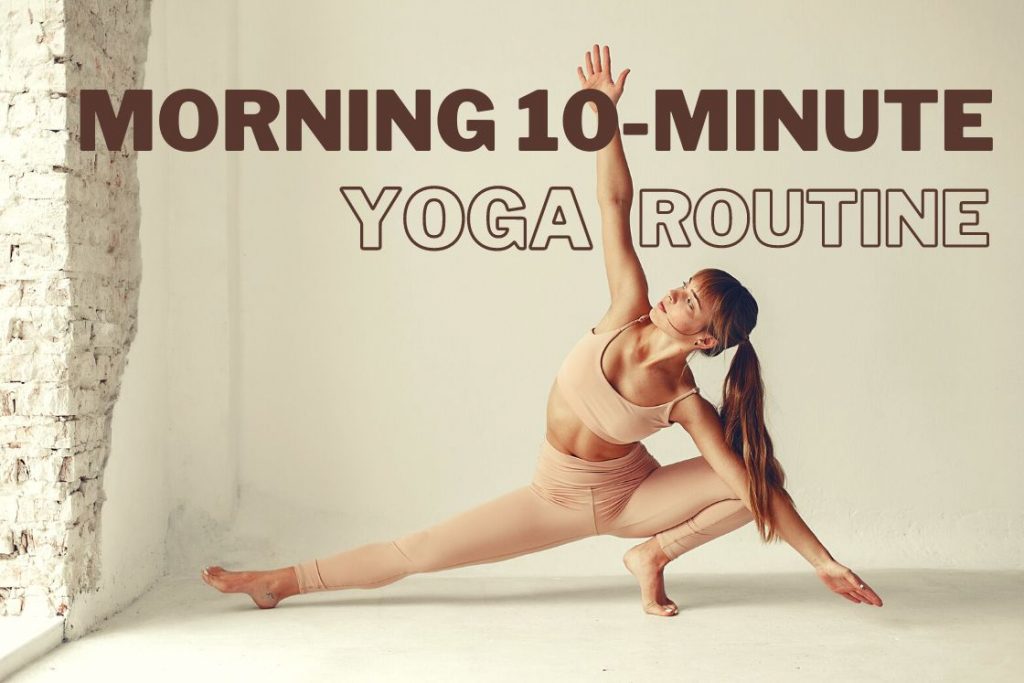
Yoga poses are best performed in the morning because they prepare your body and mind for the day ahead.
There may be days when you wake up feeling drained, achy, or tense, physically or mentally. This could be because you didn’t move around much during the day, spent a great deal of time working on your laptop, or just had a stressful day.
Stretching out first thing in the morning can be an essential step for your body and mind.
A morning yoga routine opens you physically and energetically by relieving some of the sleep kinks and bringing the blood circulating. Practising yoga in the morning also let you gain the benefits of the fresh air of the early morning which is essential for a stress-free mind.
You can feel energized and productive after a quick 10-minute yoga session, which is a great attitude to keep throughout your day.
To help you in your endeavor, we have curated a list of 14 yoga poses and stretches. They will wake up your mind and body and leave you feeling energetic and ready to face the day with a positive mindset.
But before that, let us look at some tips you should remember to perform morning yoga
Tips for practising morning yoga
Before you build a regime, keep the following points in mind:
- Experiment with a few asanas beforehand to see which suits your body and purpose.
- Always perform a few warm-up poses or stretches before you start your session.
- Start slow and gradually build up the energy through deeper poses and stretches.
- You can include one or two energizing pranayamas such as bhramari or ujjayi in your routine.
- While performing asanas, be aware of taking stable, deep, and slow breaths.
- Perform your yoga routine for at least 10-15 minutes.
- If you have a hard time getting up from the bed, customize your poses and stretches to be done on the bed.
- You need to be an empty stomach before yoga practice so make sure you have emptied your bowels before getting on the mat. Drinking a glass of warm water is acceptable to keep you hydrated.
Also read: Brahma Muhurta – Ideal time for yogis to meditate in the morning
Yoga poses and stretches for a morning routine
1. Tadasana (Mountain Pose)

Benefits: improve posture, tone core muscles, strengthen back, hips, and legs.
A great pose to start your morning yoga sequence, mountain pose is akin to a meditative pose that promotes grounding. Even though you are standing straight in this pose, your entire body is active in producing the energy to engage all body muscles. This simple beginner pose gives you the chance to look inwards and enhance bodily awareness.
Physically, it lengthens your spine, and strengthens the ankles, knees, and feet, while toning the abdominal muscles.
Instructions
- Stand straight on a yoga mat with your feet parallel to each other.
- Keep your feet slightly apart so that your ankles do not touch each other. Or instead of the feet, you can only spread your heels.
- Lift the balls of the feet and fan the toes and bring them back on the mat to create a wider base for weight distribution.
- Draw in your navel and keep the back straight to maintain the natural curve of the spine.
- Keep your shoulder away from the ears and roll your shoulder blades back and then down. This will open up your collar bones and chest.
- Let your arms hang naturally beside you.
- Ensure that your chin is not tilted down or upwards. Keep your head straight and gaze straight ahead at an immovable point.
- Stay in this pose for 5-10 breaths.
2. Uttanasana (Standing forward bend)
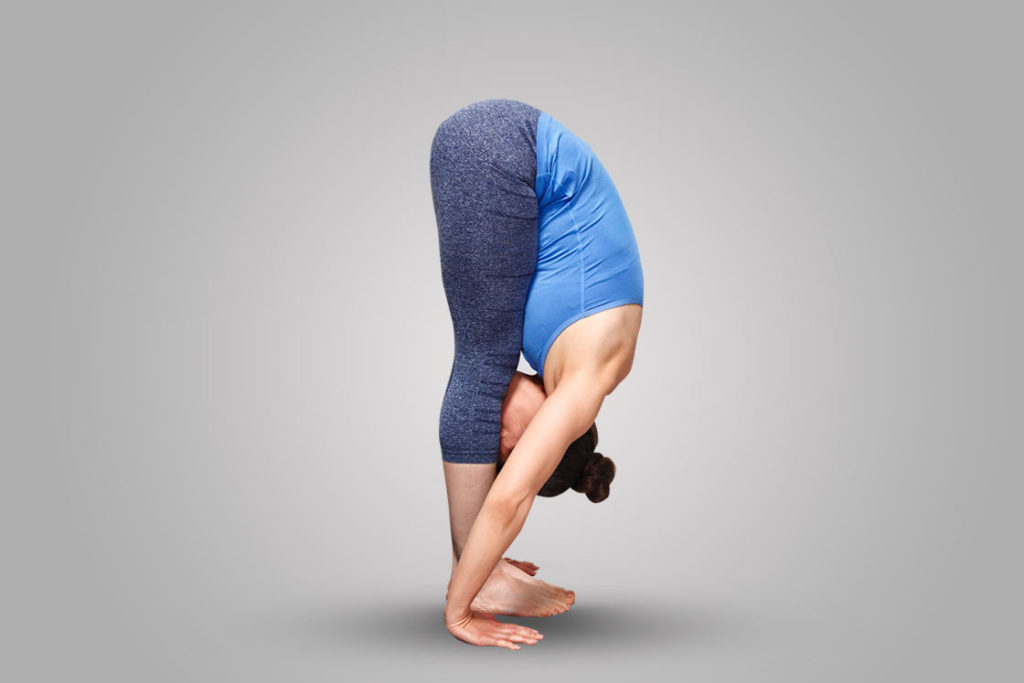
Benefits: Relieve back stiffness and neck tension, increase hip flexibility, and stretches the hamstrings and calves.
Including uttanasana in your morning yoga routine relieve any tensions or stiffness you have in your back muscles. It stretches the pelvic area where a lot of emotional as well as physical stress gets accumulated.
Performing this pose will massage your abdominal organs, stretch your hamstrings, and lengthen your spine. It opens your chest and encourages blood flow to the head.
Instructions
- From the mountain pose, start bending forward from your hips while keeping a straight spine.
- As you bend, slide your arms down the back of the thighs till they reach the ankles.
- If you are unable to bring your hands to that extent, you can rest them on a stack of yoga blocks (or books, if blocks are not available). The prop should be placed on the outside of your feet.
- Let your head hang freely.
- Stay in this pose for at least 3-5 breaths.
You may also like: How to use blocks to modify yoga poses
3. Cat/Cow Pose (Marjaryasana/Bitilasana)
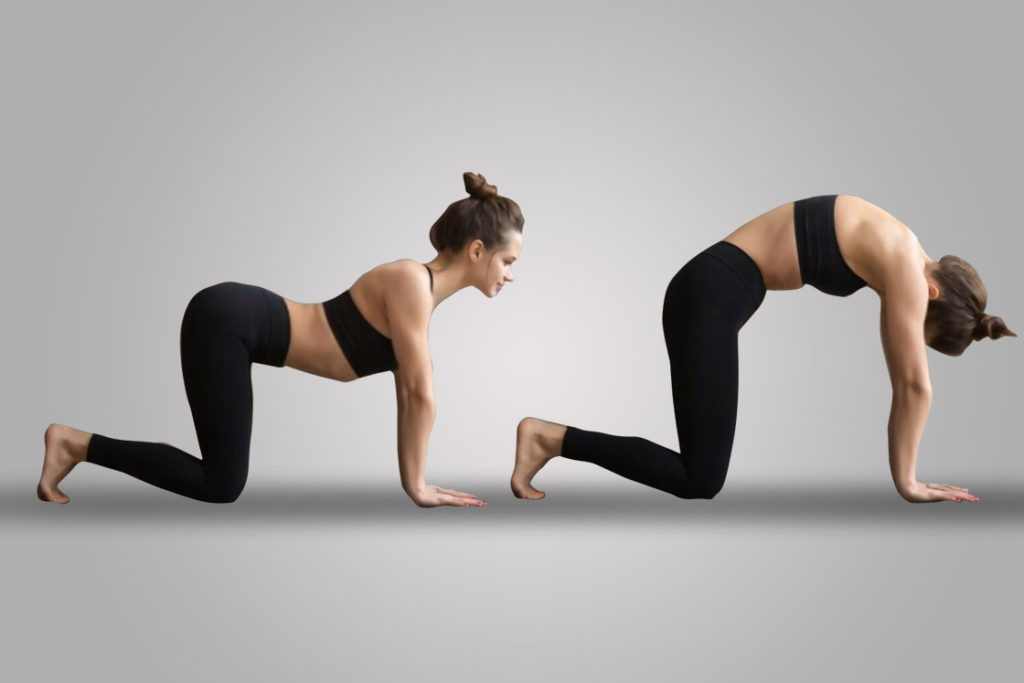
Benefits: Strengthen the spine, improve posture and balance, and release tension of the neck and upper back.
In your morning yoga routine, a pose is a must that works on the movement of your spine. Cat pose and cow pose combinedly make a dynamic movement that wakes up your spine in the morning after night sleep.
The up and down movement in the cat-cow pose boosts blood circulation while also strengthening the back and balancing the body. The spine is stretched and mobilized in this mild and easy forward-backbend movement.
Instructions
- Come to the tabletop position. Spread your hands evenly to support your wrists and arms.
- Your shoulders should be stacked above your wrists and hips above your knees.
- Ensure that the body weight is evenly distributed on all four limbs.
- Inhale and dip your stomach. Push the sitting bones up, drawing the head, shoulders, and chest forward.
- Exhale while curving your back like a cat, pulling your belly button closer to your spine and your pelvis closer to your rib cage, and dropping your head toward the floor.
- Perform this movement for at least 1 minute or 5-10 times.
4. Adho Mukha Svanasana (Downward Facing Dog Pose)
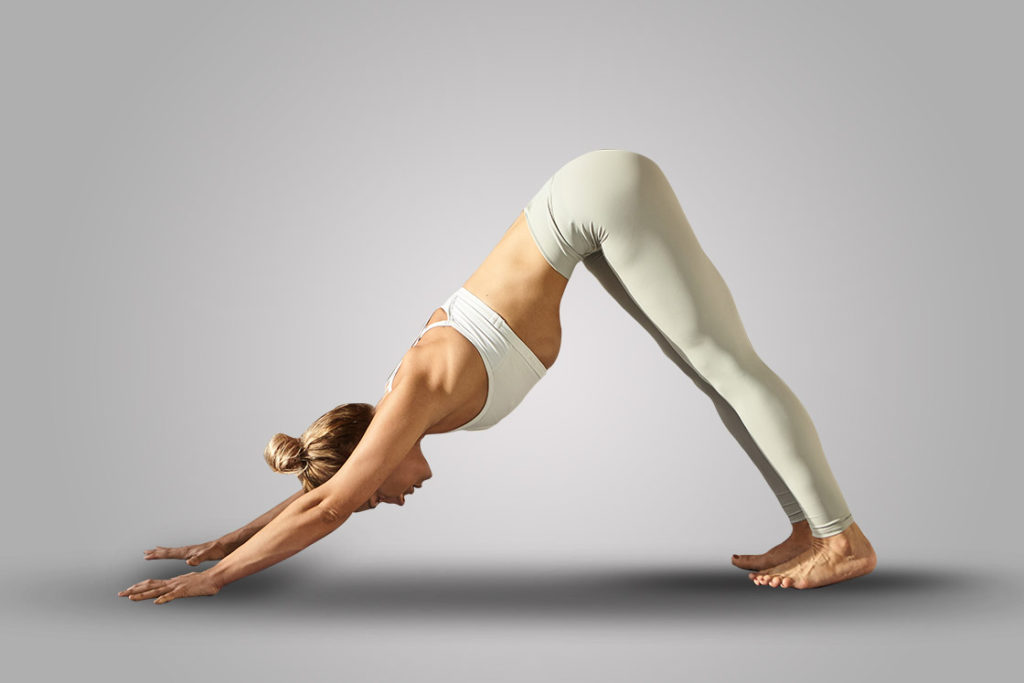
Benefits: Elongate the spine, strengthen hands, wrists, and fingers, and improve circulation
A downward dog in the morning yoga routine will revitalize the body and makes you feel rejuvenated. If you feel tired or sluggish after waking up, it will refresh your nervous system and fill your up with energy.
Anatomically, downward dog pose strengthens your arms and legs while stretching your shoulders, hamstrings, calves, and feet. Your glutes, lower back, and spine also gets a good stretch and workout.
Instructions
- Come to a tabletop position with your arms parallel to each other. Your arms should be placed shoulder-width apart and your legs hip-width apart as well. Spread your finger to distribute the weight evenly on your hands.
- Pressing your hands and feet firmly onto the ground, lift your knees upwards. Keep lifting your knees till your legs are straight and the buttocks are pointing upwards.
- Stretch your tailbone towards the ceiling to further lift from the hips and keep your back straight.
- To stretch your hamstrings, press your heels on the ground while keeping a micro bend in the knees.
- Make sure that your weight is evenly distributed in your arms and legs. Your body should form an inverted V shape.
- To give support to your arms and feet, place a folded blanket under your heels and keep yoga blocks at their tallest height to place your hands in them.
- Let your head and neck hang freely and keep a fixed point as your focal point for a steady gaze.
- Hold this pose for 5 breaths.
5. Virabhadrasana I (Warrior I Pose)
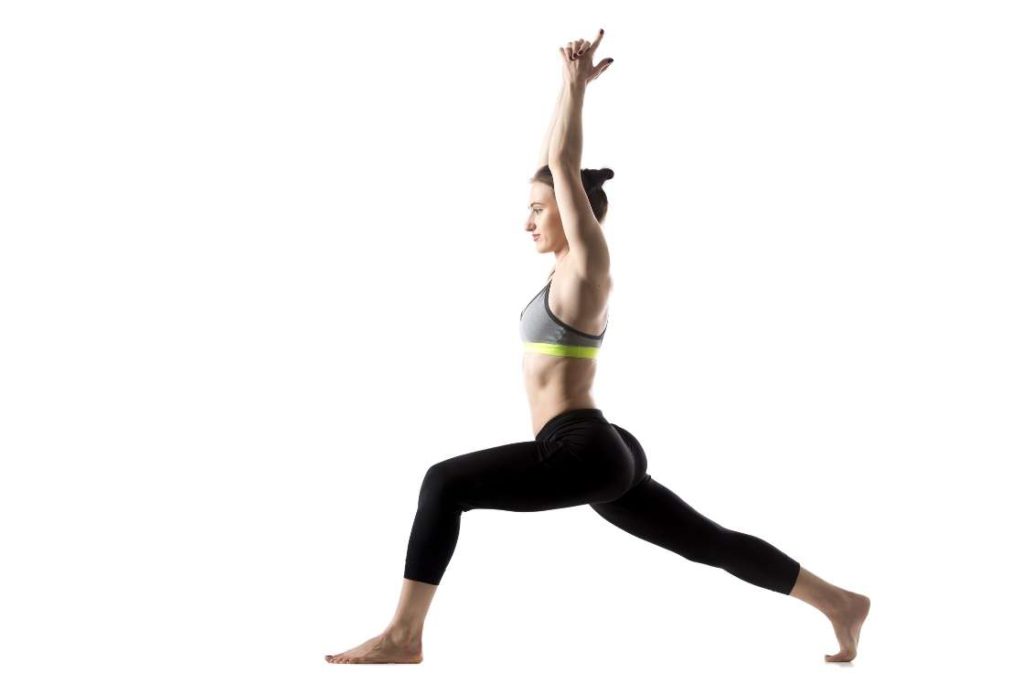
Benefits: strengthens the legs and upper arms and stretches the muscles around the hips
When you perform Warrior 1 pose first thing in the morning, your mind will be focused and your body will be engaged in establishing proper strength.
This pose strengthens the legs and opens the hips and chest. It also works on strengthening the core while stretching the hamstrings and quads.
Instructions
- Start by standing in Tadasana (Mountain Pose), facing the shorter end of the mat.
- Step your left foot to the back, place your foot firmly on the floor, and turn it to a 45-degree angle.
- Bend the right knee to make a 90-degree angle. Your thighs should become parallel to the floor and your knee should be stacked over the ankle.
- Make sure your right heel is in line with the left foot arch.
- Stretch your arms upwards with palms facing each other. Open your chest, lengthen the spine and draw in your abdomen.
- Your hips should be facing forward and not tilting sideways.
- Press down on your left foot to keep your spine straight and keep your shoulders away from your ears.
- You can either tilt your head upwards to gaze at the fingertips or keep it straight to gaze at the front.
- Hold this pose for 3-5 breaths then repeat the process with the other leg.
You may also like: What is the best time to do yoga in the morning?
6. Bhujangasana (Cobra Pose)
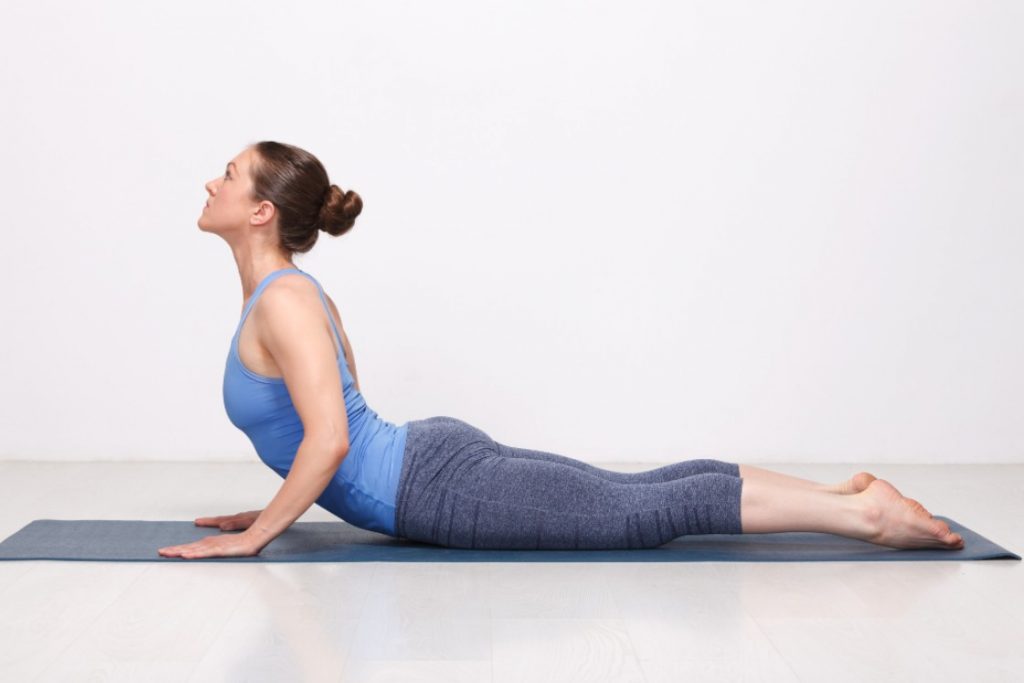
Benefits: stimulate abdominal organs, tones the buttocks and opens the heart and lungs
Cobra pose puts gentle pressure on the abdomen and pelvis. Practising it early in the morning will boost your digestion and keep it healthy throughout the day. Moreover, backbends enhance the secretion of hormones and chemicals that are beneficial to the body. They are helpful in generating self-confidence, self-esteem, and willpower.
Your upper body is stretched in the cobra pose, with an emphasis on your tense shoulders, which also helps to relieve back pain. Any remaining discomfort or stress is relieved as the muscles in the back, neck, and spinal column are stretched thoroughly.
Instructions
- Lie down on your stomach and place your forearms beside your ribs. Keep your legs hip-width apart or joined together. The top of your feet should face down with soles facing up.
- Spread your fingers to create firm support and spread the weight evenly. Bring your palms below your shoulders with your elbows close to the torso and parallel to each other.
- Putting pressure on your hands, lift your head and your chest upwards, keeping your pelvis and legs on the ground. Your pelvis shouldn’t lose contact with the ground.
- Keep your shoulder away from your ears and shoulder blades pressed towards the back.
- Stay in this pose for 4-5 breathes.
7. Seated Forward Bend (Pashchimottanasana)
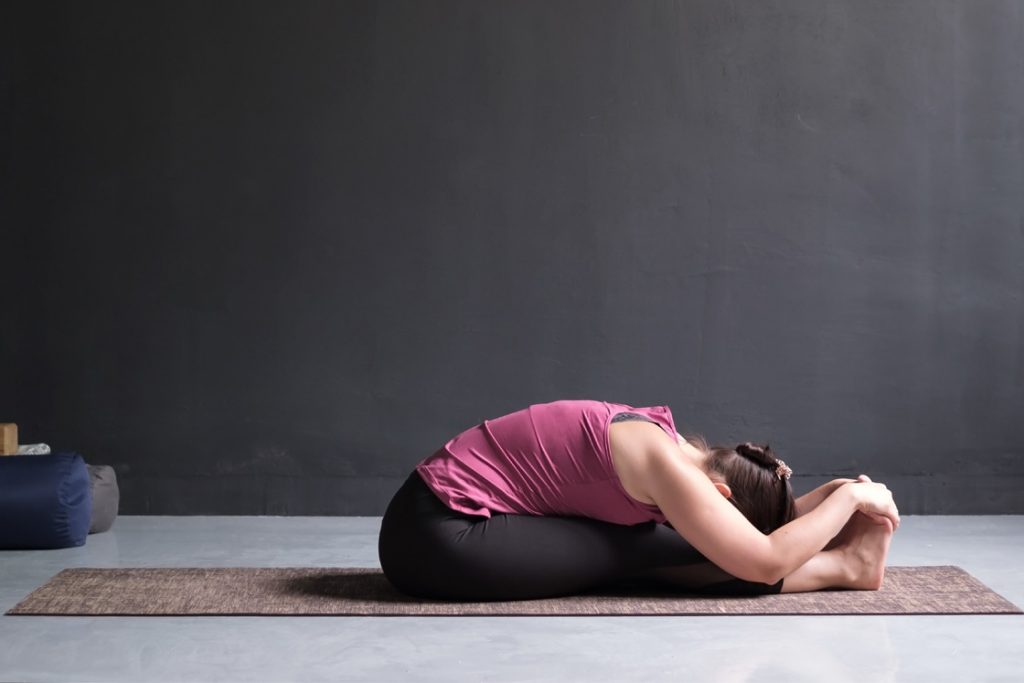
Benefits: Stretch spine, shoulders, and hamstrings, and improve flexibility
One of the most energizing approaches to begin the day is to feel the effects of opening the back travel across the body.
Seated forward bend or paschimottanasana dissipates any constriction that had developed overnight or even from the day before. The stomach and pelvic areas are toned and massaged during this restful pose, which is excellent for promoting digestion in the morning.
Instructions
- Sit in a staff pose (dandasana) with a straight spine. Place your palms on the floor beside your hips.
- Start bending forward from the hips without rounding your back.
- Bring your arms forward and slide them toward your legs or as far as they will go.
- Keep your head aligned with the spine. Do not tilt it back or bend forward.
- Hold the side of your feet with your hands if you can reach them. Or else you can hold your ankles or any space above the ankles. You can also use a strap to bridge the gap between your hands and feet.
- Keep bending till you can no longer go further. You can keep a cushion, a bolster, or a yoga block on your legs to place your forehead.
- Stay in this pose for as long as you want.
Also read: 11 best yoga poses to improve flexibility
8. Standing side stretching (Parsva tadasana)
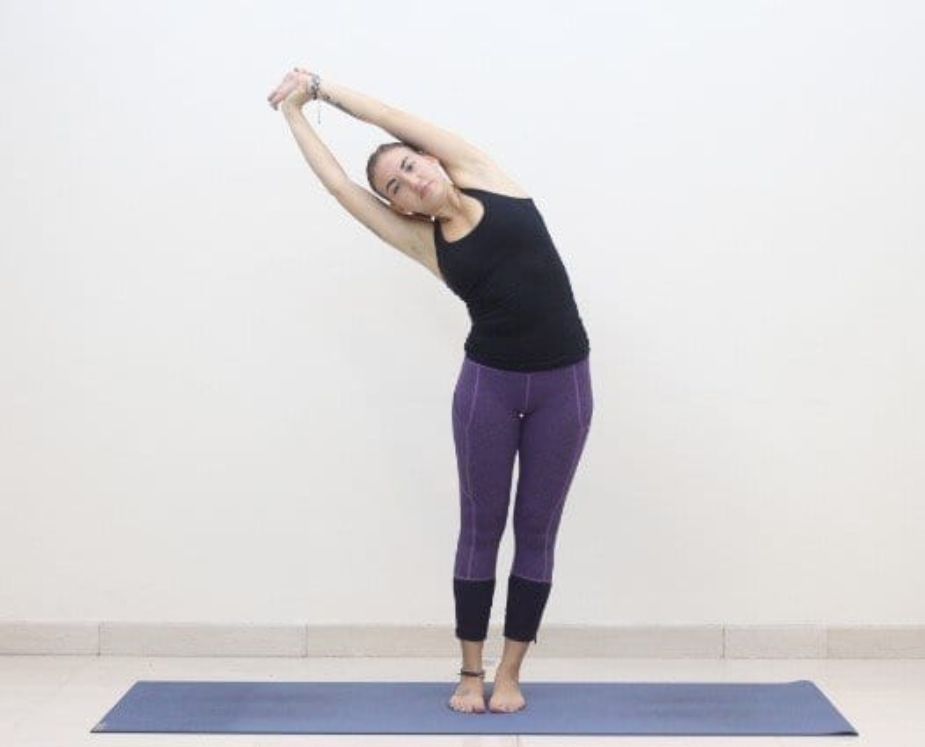
Benefits: lengthen the spine, increase flexibility and range of motion and strengthens the core
This is a variation of the mountain pose which targets the entire side of your body. This can act as a warm-up exercise before you start your morning yoga routine to open any tense muscles.
Instructions
- Stand in the mountain pose with your legs hip-width apart and hands beside your body.
- Bring both your arms overhead and clasp your hands. You can either join the palms in a namaste formation or interlock your fingers.
- Slowly bend to the right side from the hips so that you feel your entire side stretching.
- Keep your head and back straight while bending and your feet firmly grounded.
- Do not force yourself to stretch deeply. Begin with a slight bend and gradually increase the depth.
- Hold the stretch for 1 minute and return to the original position. Repeat the same on the other side.
- Perform this stretch 5-7 times.
Also read: How to perform upward salute pose and its benefits
9. Half Split or hamstring stretch
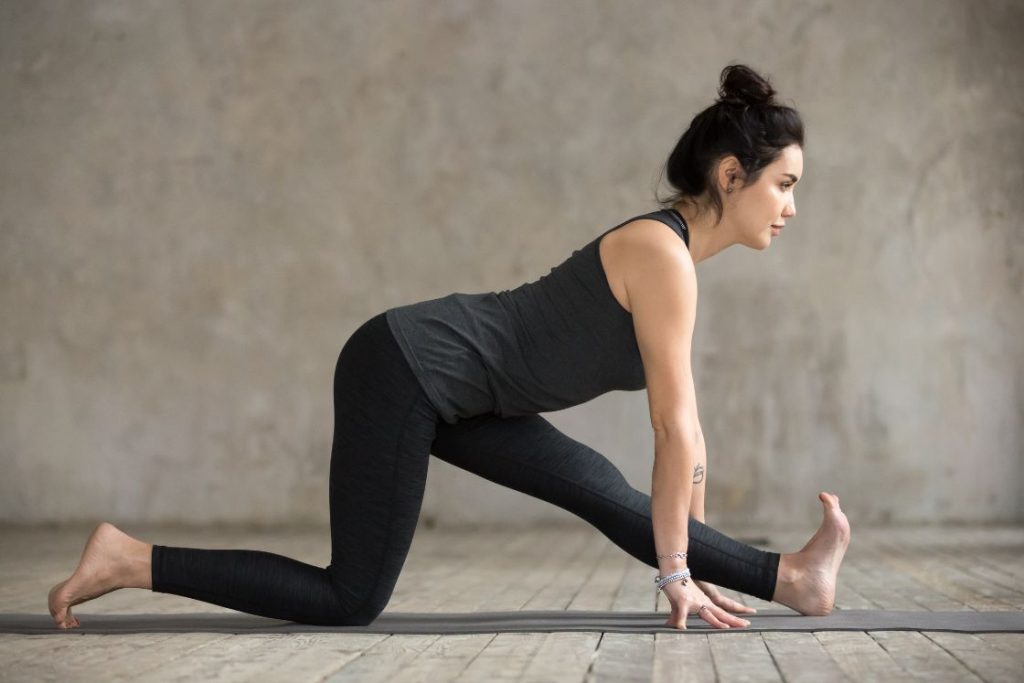
Benefits: Improve range of motion of hips, elongate the spine and help calm the mind
If you walk too much or are an athlete who uses the legs a lot, this morning yoga stretch is perfect to keep your hamstrings and calf muscles active and warmed up. Half split stretch is a variation of hanumanasana pose in yoga.
Doing half split in the morning will energize lower body parts and hips and keep them stimulated by removing any kinks and stiffness.
Instructions
- Come to a kneeling position with your body upright.
- Bring your right leg forward such that the heel is touching the ground and your leg is straight. Your toes will be pointed upwards.
- Bend forward and frame your right foot with your arms placed on either side of it. Spread your finger on both hands for firm stability.
- Lean onto your right leg while sending your hips back.
- Do not round your back or bend your knee while doing this action. Go as far as your back, hips, and knee allow.
- Let your head hang freely.
- Stretch for 1 minute and come back to the original position gently.
- Perform the same process with the left leg.
- Repeat the procedure 3-5 times.
10. Modified Child’s Pose (Balasana)
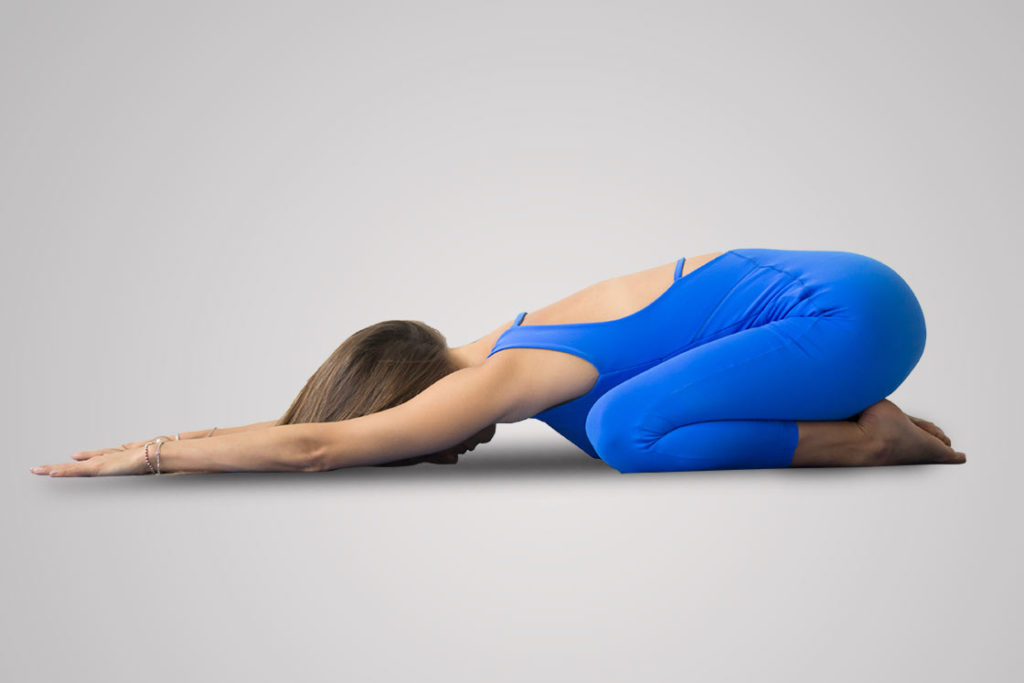
Benefits: Increase blood circulation to the head and stretch the spine, thighs, hips, and ankles.
Nervous system relaxation and discomfort relief are both possible in the child’s pose. It’s an excellent pose for relaxing your upper body and elevating your head over your heart to improve blood flow to your head. It also gives a gentle stretch and release to the chest, back, hips, and shoulders.
Instructions
- Come to the tabletop pose. Use a folded blanket or towel under the knees for more support.
- Keep our arms slightly wider than shoulder-width and legs hip-width apart.
- Place the top of your feet flat on the ground. Spread your fingers to distribute the weight of your upper body.
- Gradually move your hips towards your heel such that the stomach falls between your thighs.
- Let your arms remain in the same position so that as you move back, you can feel a stretch in your arms, shoulders, shoulder blades, and back muscles.
- Move as far back as you can. You should ideally be able to place your buttocks on your heels to come to the original child’s pose.
- Stay here for 1 minute and come back to the original position.
- Do this movement 5-10 times.
11. Happy Baby Pose with side-to-side rocking
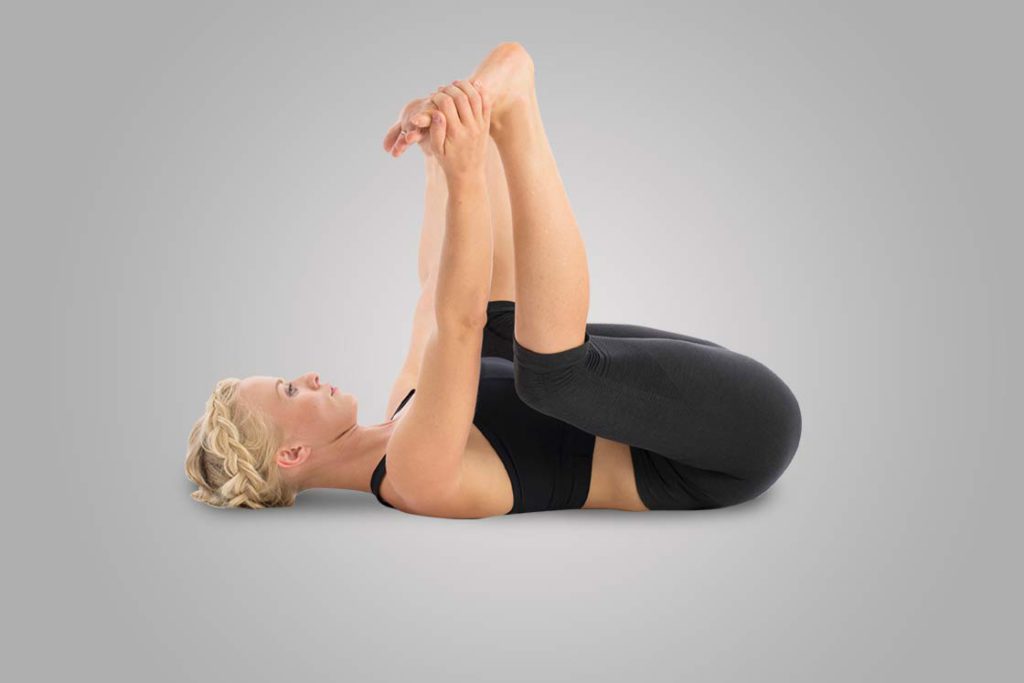
Benefits: Stretch the hamstring, lower heart rate, and reduce back pain
In this pose, your abdominal organs and your excretory organs get pressed which promotes digestion and bowel movement in the morning.
It’s one of the best yin yoga stretches for hips. Hips often get stiff due to prolonged sitting. Your lower back can also be stretched in this pose as a result of the side-to-side movement.
Instructions
- Lie down on your back with your feet on the ground and knees bent.
- Lift both your legs and bring the knees as close to the chest.
- Spread your legs so that the knees come in line with your armpits. Your ankles should also be in line with your knees.
- Hold the outside of your feet with your hands.
- Roll slightly on your right and then towards the left in one fluid motion. Keep your head and upper back while turning the rest of the body. Do not turn on the side completely.
- Perform this movement at least 5-7 times.
You may also like: Best yoga poses to relieve back pain recommended by experts
12. Supine Spinal Twist
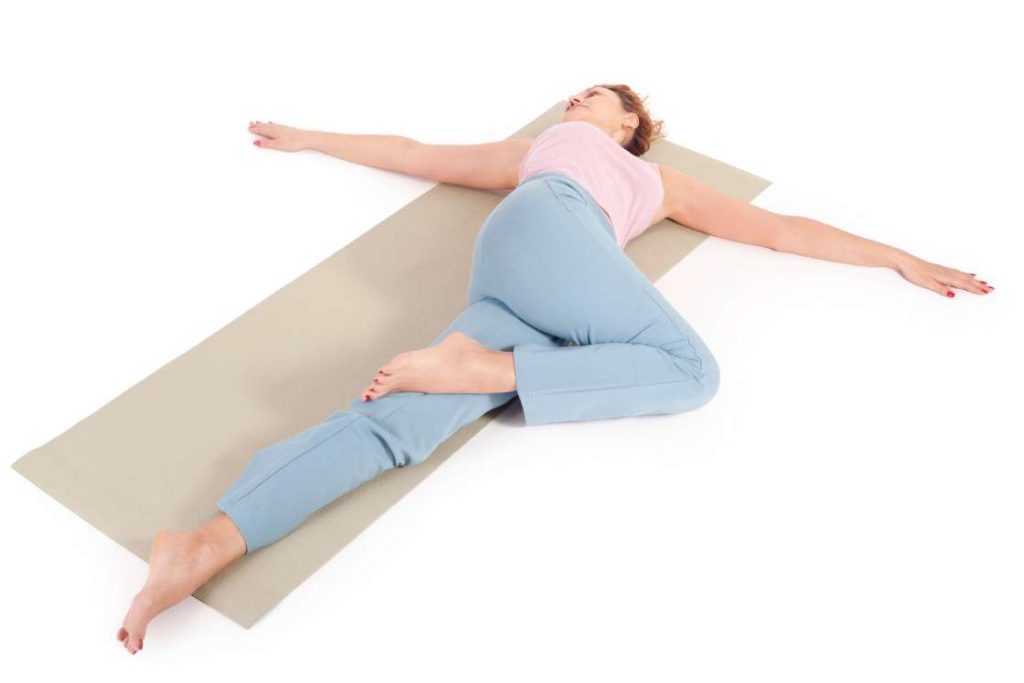
Benefits: Relieve lower back pain, open the shoulders and massage the abdominal organs
This pose is a good stretching exercise in itself. Your lower back gets complete focus and turning on one side at a time improves spinal mobility while releasing the lower back muscles.
Instructions
- Lie on your back with your legs stretched straight and arms spread to the side in a straight line.
- Bend your right knee and bring it towards your chest.
- Slowly bring your right knee over to the left side of your body, twisting the lower back.
- Turn your head on the opposite side of the twist, i.e. the left side, and fix your gaze on the left-hand fingers.
- While twisting, make sure your shoulder blades are touching the ground at all times.
- To deepen the stretch, gently hold the knee with your right hand and push it down.
- Stay in this position for 5-7 breaths and repeat with the other leg.
You can do this stretch with both legs bent as well. Instead of bringing one leg towards the chest bring both legs and place them on the opposite side of your body.
13. Knee to chest stretch (Apanasana)
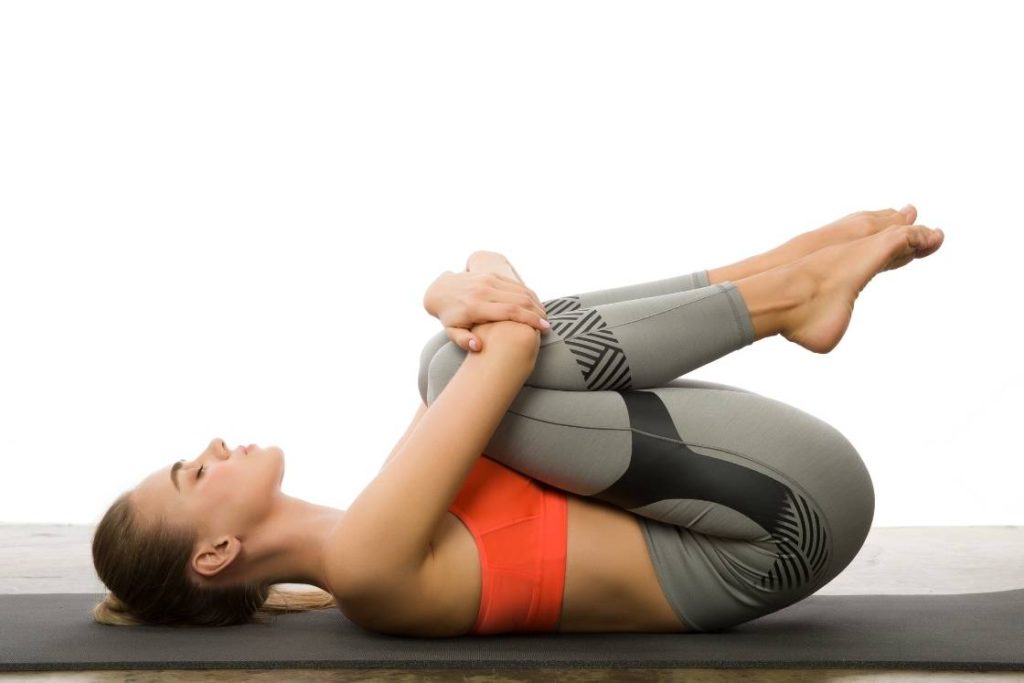
Benefits: Increase hamstring flexibility, promotes good posture and stretches the buttocks, or glutes.
Doing this pose is a good way to stimulate the abdominal and pelvic organs. This will help in activating the digestive and elimination tract. Bending the leg towards the chest will strengthen the knee, stretch your thighs and improve your overall leg flexibility. It is also a good way to stretch the lower back.
Instructions
- Lie on your back with your legs stretched straight and arms beside your body.
- Slowly bend your knees and bring them as close to the chest as possible.
- Hold your knees with both your hands or you can wrap your forearms around them.
- Do not lift your head or upper back when you hold your knees.
- Decrease the distance between your chest and knees gradually to increase the stretch in the lower back.
- Hold the knee for 1 minute and gently release. Repeat the process with the other leg.
- Practice this stretch 5-7 times.
14. Bridge Pose with up and down movement
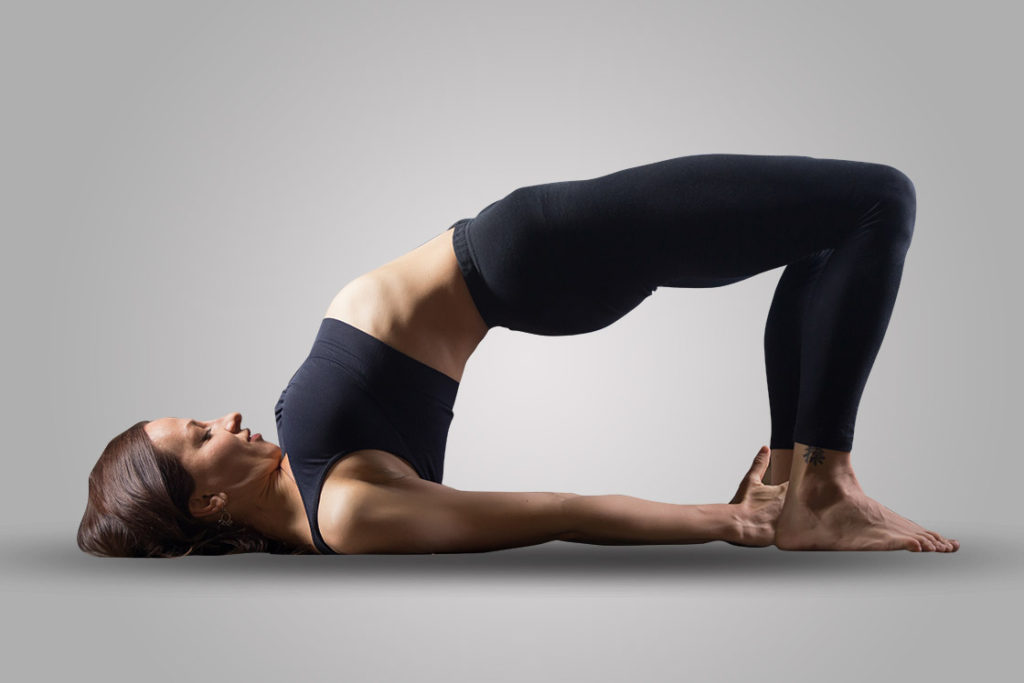
Benefits: Rejuvenate tired legs, improve digestion and open chest, heart and hip flexors
Practising this variation of the bridge pose will help in elongating the psoas muscle (muscle connecting the lower back to the upper thigh from the side) along with stretching and strengthening it.
It will also stretch your lower and middle back, strengthen the knees, and stretch the thighs and glutes.
Instructions
- Lie down on your back with your legs bent at the knees. Spread them hip-width apart and press your soles firmly on the ground.
- Your lower legs should be parallel to each other and your knees in line with your ankles.
- Place your arms beside you, palms facing down.
- Engage your core and soles of the feet and take the support of the arms to lift your hips off the mat.
- Keep pressing down your soles and lift your thighs, hips, lower back, and upper back. Your shoulder blades and head should remain stable and on the mat.
- Hold this position for 1 minute and gently bring down your hips to the ground.
- Relax for a few seconds and again lift your hips upwards.
- Perform this up and down motion 5-10 times.
Conclusion
Performing yoga in the morning can be energizing. It will fill you with vigor and it is a great way to wake up your mind and body. Performing a combination of the above poses and stretches will leave you feeling refreshed throughout the day.
